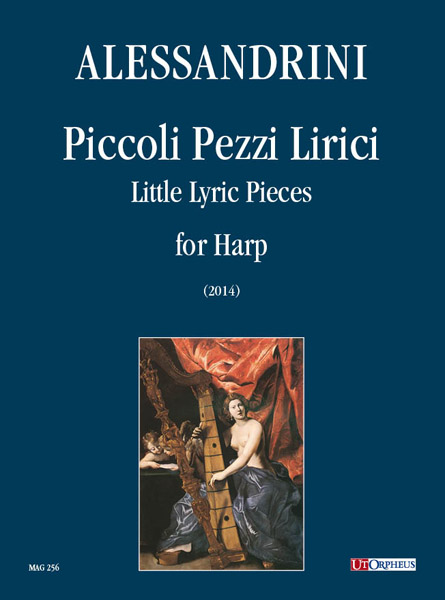I Piccoli Pezzi Lirici per arpa sono tredici brani espressivi e sentimentali scritti nel 2014 da mio padre, il compositore Giuseppe Alessandrini.
Egli è pianista e compositore, già docente di composizione presso il Conservatorio di Verona e, naturalmente sollecitato dal fatto di avere una figlia arpista, si è interessato a questo strumento componendo molto sia per sola arpa, che per arpa ed altri strumenti.
Il suo catalogo per arpa è già piuttosto numeroso, forse il più nutrito tra quello dei compositori italiani contemporanei: Solo per arpa (1974), Sequenza ’77 per arpa (1977), Piccola Suite per arpa (1983), Flhar per flauto e arpa (1987), Une Fleur per violino e arpa (1994), Une Fleur per due arpe (1994), Sonata in tre tempi per arpa (1998), 8 Pezzi facili per arpa (2000), Flhar n. 2 per flauto e arpa (2001), Canone n. 2 (moto retto) per arpa o clavicembalo (2004).
I tredici pezzi raccolti in questo volume, però, nascono non solo dalla creatività del compositore ma anche da una mia precisa richiesta: quella di aver finalmente un’opera didattica scritta con linguaggio moderno che, allo stesso tempo, permettesse agli studenti di arpa di entrare in contatto con una facile
idea di cantabilità, di fraseggio e di espressività.
Insegno l’arpa in conservatorio da più di trent’anni e l’esperienza mi ha insegnato che il repertorio di questo strumento sicuramente coglie questi due aspetti (modernità e liricità), solo però in momenti separati.
L’invito rivolto a mio padre è stato quindi quello di concentrare in brani di facile e media difficoltà le esperienze dei vari Salzedo, Andres, Damase per esempio da una parte e degli ottocenteschi Bochsa, Thomas, Godefroid dall’altra.
Essendo l’ultimo dei lavori scritti per arpa da Giuseppe Alessandrini, si può a ragione notare come il compositore, anche se non arpista, sia però grande conoscitore dello strumento e sappia sfruttare molto bene tutte le tecniche, mettendone in risalto le peculiarità.
Il mio lavoro di curatrice si è quindi limitato a cercare di valorizzare ancor più, attraverso quelle che ho ritenuto essere le migliori diteggiature, l’obiettivo principale di questa opera: la ricerca del bel suono e la cura del suono legato.
* * *
The Piccoli Pezzi Lirici for harp are thirteen expressive and tender pieces, composed by my father Giuseppe Alessandrini in 2014.
As a pianist and composer, formerly teacher of composition at Verona Conservatory, and obviously stimulated by a harpist daughter, he often worked for this instrument and composed a large number of pieces both for solo harp and for harp and other instruments. The list of his compositions for harp is quite long, perhaps the longest amongst Italian contemporary composers: Solo for harp (1974), Sequenza ’77 for harp (1977), Piccola Suite for harp (1983), Flhar for flute and harp (1987), Une Fleur for violin and harp (1994), Une Fleur for two harps (1994), Sonata in three movements for harp (1998), 8 Pezzi facili for harp (2000), Flhar n. 2 for flute and harp (2001), Canone n. 2 for harp or harpsichord (2004).
Nevertheless, the thirteen pieces presented in this volume, were born not only thanks to the composer’s creativity but also to my specific request to have a didactic collection written in a modern musical language, which allows pupils to get in touch with an easy concept of singing, phrasing, and expression.
Having been a harp teacher for more than thirty years, experience taught me that this instrument’s repertoire has both of these two features (modernity and lyricism), but always in different moments.
Thus I asked my father to concentrate the musical experiences of composers such as Salzedo, Andres, Damase – for instance – on one hand, and the 19th Century masters like Bochsa, Thomas, Godefroid, on the other hand, within some easy and medium difficult pieces.
This is the last work for harp written by Giuseppe Alessandrini, and it can be clearly noted that the composer knows very well the instrument and is able to exploit its technique as well, emphasizing its peculiarity.
My task as editor was just to find the best fingerings in order to emphasize even more the main goal of this work: the quest for a beautiful sound production and the study of the legato.
Roberta Alessandrini
